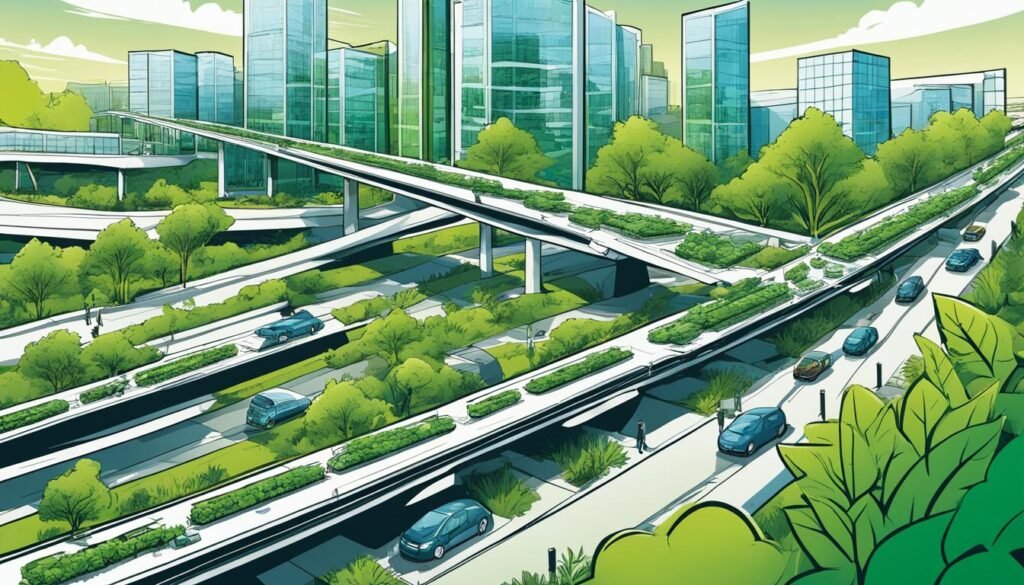The Philippines’ infrastructure development has witnessed remarkable progress over the years, with significant contributions from American involvement. Since the arrival of the Americans in 1899, there has been a steadfast commitment to improving the country’s infrastructure, creating a foundation for economic growth and a connected future.
Under the leadership of Governor William Cameron Forbes, the Americans recognized the urgent need to enhance the Philippines’ road infrastructure. Consequently, a transformative period of development commenced, encompassing the construction of roads, bridges, ports, and railways. These projects not only revolutionized Philippine society but also improved mobility, connectivity, and overall quality of life.
Key Takeaways:
- The Americans played a critical role in the development of the Philippines’ infrastructure.
- Under Governor William Cameron Forbes, extensive road projects were initiated, enhancing connectivity across the country.
- American governance and investments facilitated the introduction and adoption of concrete as a construction material.
- The United States, through USAID, continues to support and invest in various sectors to promote sustainable development and progress in the Philippines.
- The partnership between the United States and the Philippines paves the way for a brighter, more connected future.
The Impact of American Governors on Philippine Infrastructure
During the American period in the Philippines, the development of infrastructure became a priority. William Cameron Forbes, also known as the “father of road building,” played a pivotal role in shaping the country’s infrastructure during his governorship from 1909 to 1913.
Forbes initiated massive road projects, leading to a significant increase in the number of bridges and culverts. By 1913, the Philippines saw an impressive rise in the bridge count, from 3,280 to 5,660, thanks to Forbes’ vision and dedication to improving connectivity.
Continuing Forbes’ legacy, Governor General Francis Burton Harrison furthered the road-building efforts. One notable achievement was the construction of several bridges, now known as Harisson Bridges, which connected various communities across the archipelago.
| Governor | Term | Infrastructure Contributions |
|---|---|---|
| William Cameron Forbes | 1909-1913 | Initiated massive road projects, increased bridges and culverts |
| Francis Burton Harrison | 1913-1921 | Constructed Harisson Bridges for improved connectivity |
The impact of these American governors on Philippine infrastructure laid the foundation for progress and development. The road-building efforts initiated by Forbes and continued by Harrison not only enhanced mobility but also facilitated economic growth and social transformation across the nation.
With their foresight and dedication to Philippine development, William Cameron Forbes and Francis Burton Harrison left a lasting legacy in the form of improved infrastructure, supporting the country’s growth and progress.
The Concrete Revolution in American Colonization
The American colonization of the Philippines from 1898 to 1945 had a profound impact on the country’s infrastructure development, including the introduction of concrete as a revolutionary construction material. This era coincided with the industrial production of Portland cement, marking a significant milestone in the use of concrete in architectural and engineering projects.
Daniel Burnham, an American architect, played a pivotal role in shaping the cityscape of Manila through his implementation of the City Beautiful plan. This visionary urban development initiative focused on creating aesthetically pleasing and functional spaces, incorporating government buildings, ports, forts, bridges, roads, housing, and prisons into the fabric of Manila.

The American colonization period marked a concrete revolution, transforming the landscape of the Philippines and leaving a lasting legacy in urban planning and architecture.
Concrete, with its unique properties of strength, durability, and versatility, became the material of choice for constructing large-scale infrastructure projects during this time. Its use in the City Beautiful plan not only created visually striking structures but also showcased the influence of American architectural ideals and design principles.
Moreover, the widespread adoption of concrete in the American colonization period paved the way for new forms of global governance. The implementation of modern infrastructure projects shaped the development and progression of the Philippines, driving economic growth, enhancing connectivity, and fostering a sense of national pride.
Advantages of Concrete in American Colonization
The use of concrete in architectural and engineering projects during the American colonization period offered several advantages:
- Strength and durability: Concrete provided robustness and longevity to structures, ensuring their ability to withstand various weather conditions and environmental factors.
- Flexibility: Concrete’s moldable nature allowed for the construction of intricate architectural features and innovative design elements.
- Mass production: The industrial production of Portland cement facilitated the widespread use of concrete, enabling efficient and cost-effective construction.
- Standardization: Concrete offered a standardized building material, allowing for consistent quality in construction across various projects.
The utilization of concrete in American colonization not only transformed the physical landscape of the Philippines but also influenced subsequent architectural and infrastructural developments in the country. The legacy of this concrete revolution can still be observed in the enduring structures that exemplify the fusion of American and Filipino design influences.
American Funding for Philippine Infrastructure
The U.S. Agency for International Development (USAID) is committed to supporting the development of infrastructure in the Philippines. With a pledge of $135 million in new funding, USAID aims to promote investment, innovation, and inclusive prosperity in the country.
This funding encompasses various sectors, including:
- 5G Rollout: USAID will support the Philippines’ efforts in rolling out 5G technology, facilitating faster and more reliable connectivity to drive economic growth and digital transformation.
- Higher Education Partnerships: USAID will establish partnerships with Philippine universities to enhance higher education and foster innovation and workforce development. These collaborations will provide opportunities for students to gain skills that align with industry demands.
- Transparent and Sustainable Infrastructure Development: USAID will assist the Philippine government in developing transparent and sustainable infrastructure projects. By promoting good governance practices and involving private sector participation, infrastructure development can be more efficient and beneficial for the Filipino people.
- Critical Minerals Production: The funding will support increased production of processed minerals in the Philippines, contributing to the growth of downstream industries such as electric vehicle manufacturing and ICT equipment production.
- Clean Energy Auctions: USAID will partner with the Philippines Department of Energy to conduct clean energy auctions, promoting the deployment of solar, wind, biomass, and waste-to-energy projects. This initiative will accelerate the country’s transition to cleaner and more sustainable sources of energy.
- Climate-Resilient Water Security: USAID will prioritize climate-resilient water security by investing in projects that enhance water resource management, improve water access and quality, and strengthen resilience to climate change impacts.
- Health Security and Disaster Resilience: The funding will also support health security initiatives, including strengthening laboratory capacity, disease surveillance, risk communication, and emergency preparedness. It aims to address public health challenges such as the double burden of non-communicable diseases and tuberculosis.
This substantial investment by USAID underscores the United States’ commitment to supporting the development and progress of the Philippines. By focusing on critical areas such as infrastructure, clean energy, higher education, and water security, this funding will contribute to the country’s sustainable development and pave the way for a prosperous future.
Open RAN Interoperability Lab for 5G Rollout
As part of the funding from USAID, the United States plans to establish an Open RAN Interoperability Lab in Manila. This lab will advance the Philippines’ 5G rollout, strengthen its innovation economy, and provide digital upskilling opportunities to Philippine workers.
The Open RAN Interoperability Lab will serve as a hub for 5G professionals, offering hands-on training and fostering collaboration. Current and aspiring professionals in the field will have access to cutting-edge technologies and practical training, enabling them to gain valuable skills and expertise in the rapidly evolving 5G landscape.
In partnership with the Asia Open RAN Academy, the lab will facilitate knowledge exchange with vendors and operators deploying open RAN networks worldwide. By leveraging this collaboration, Philippine professionals can learn from international experts, share best practices, and contribute to the advancement of open RAN technologies.
“The establishment of the Open RAN Interoperability Lab is a game-changer for the Philippine 5G ecosystem. It will not only accelerate the deployment of 5G networks but also empower local talents with the necessary skills for the digital future.” – [Insert Name], [Insert Position], [Insert Organization]
The lab’s partnership with the Asia Open RAN Academy underscores a commitment to digital upskilling and ensures that the Philippines remains at the forefront of 5G innovation. This collaborative effort brings together USAID, local Philippine universities, and technology companies to create an ecosystem that fosters learning, research, and development in the field of open RAN.
With the establishment of the Open RAN Interoperability Lab, the Philippines is poised to become a regional hub for 5G expertise and an attractive destination for international investments in the telecommunications sector.

| Benefits of the Open RAN Interoperability Lab |
|---|
| 1. Enhanced 5G rollout in the Philippines |
| 2. Strengthening of the innovation economy |
| 3. Digital upskilling opportunities for local workers |
| 4. Collaboration with international experts in open RAN |
| 5. Development of a thriving 5G ecosystem in the Philippines |
Supporting Higher Education in the Philippines
USAID recognizes the importance of higher education in driving innovation, workforce development, and entrepreneurship in the Philippines. To foster the growth of skilled professionals and promote innovation, USAID will launch a $30 million higher education partnership, collaborating with Philippine universities.
The partnership will focus on key areas that contribute to the overall development of the education system. This includes curriculum development, faculty development, higher education policy and management, research, and community engagement. By investing in these areas, USAID aims to enhance the capabilities of Philippine universities and equip students with the necessary skills for the evolving job market.
Innovation plays a crucial role in driving economic growth, and with this partnership, USAID aims to create an ecosystem that encourages innovation and entrepreneurship. By providing opportunities for students to develop their entrepreneurial skills, the partnership seeks to empower future graduates to become job creators and contribute to the country’s economic development.
Curriculum development is another key aspect of the partnership, ensuring that the educational programs offered by Philippine universities align with industry needs. By enhancing the curriculum, students will acquire the relevant and up-to-date knowledge and skills required to succeed in their chosen fields.
The partnership will also emphasize faculty development, providing opportunities for professors to enhance their teaching methodologies, research capabilities, and professional growth. By investing in faculty development, the partnership aims to create a conducive learning environment and foster a culture of continuous improvement.
Higher education policy and management will be another focus area, facilitating effective governance and administration of Philippine universities. This will enable universities to make informed decisions, implement best practices, and improve overall institutional performance.
Research collaboration and community engagement will further enhance the partnership, providing students and faculty with opportunities to work on real-world challenges and contribute to the development of the local community.
Through this higher education partnership, USAID aims to strengthen the Philippine education system, nurture innovation and entrepreneurship, develop a competent and skilled workforce, and drive overall socioeconomic progress in the country.
Advancing Transparent and Sustainable Infrastructure Development
USAID, in collaboration with the Philippine government, is committed to driving transparent and sustainable infrastructure development in the country. With an investment of $5 million, this partnership aims to support project preparation and establish public-private partnership structures for critical infrastructure projects, including railways, ports, and transport systems.
The primary focus of this initiative is to promote transparency, participation, and stakeholder engagement throughout the infrastructure project cycle. By ensuring transparency, both the public and private sectors can contribute to the decision-making process, enabling more efficient and effective implementation of infrastructure projects that meet the needs of the Filipino people.
This collaboration builds upon the existing partnership between USAID and the Philippine government, which aims to enhance the country’s capacity to plan and deliver high-quality public investment projects. By providing funding and expertise, USAID supports the Philippine government in preparing projects that adhere to international standards of transparency and sustainability.
Through the establishment of public-private partnerships, the collaboration seeks to leverage the strengths and expertise of both sectors to drive infrastructure development. Public-private partnerships have proven to be successful models for delivering infrastructure projects in many countries, allowing for efficient resource allocation and risk sharing between the government and private sector.
The benefits of public-private partnerships extend beyond the financial aspects. By involving the private sector, projects can benefit from their expertise, innovation, and operational efficiency. This collaboration also opens possibilities for technology transfer, knowledge sharing, and capacity building, contributing to the long-term sustainability of infrastructure projects in the Philippines.

| Benefits of Advancing Transparent and Sustainable Infrastructure Development |
|---|
| Promotes transparency, participation, and stakeholder engagement |
| Enhances project preparation for critical infrastructure projects |
| Establishes public-private partnership structures |
| Leverages the strengths and expertise of the public and private sectors |
| Facilitates efficient resource allocation and risk sharing |
| Encourages technology transfer, knowledge sharing, and capacity building |
Partnering on Critical Minerals and Clean Energy
As part of its commitment to the development of the Philippines, USAID is investing an additional $5 million to support the increased production of processed minerals in the country. This investment aims to expand downstream mineral industries, including the production of electric vehicle components and ICT equipment, while also improving governance standards in the mining industry.
Furthermore, USAID has partnered with the Philippines Department of Energy to conduct clean energy auctions. These auctions will create opportunities for the bidding of significant capacity in solar, onshore wind, biomass, and waste-to-energy projects. By promoting the adoption of clean energy sources, the Philippines will take a significant step towards achieving sustainable development and reducing its carbon footprint.
Benefits of Increased Mineral Production and Clean Energy:
- Stimulates economic growth and job creation
- Supports the development of downstream industries
- Reduces reliance on fossil fuels and promotes cleaner energy sources
- Contributes to the global transition towards sustainable development
By investing in increased mineral production and clean energy, the partnership between USAID and the Philippines will have a transformative impact on the country’s economy and environment. This collaboration aligns with the Philippines’ commitment to sustainable development and will create a pathway towards a greener future.
| Benefits of Increased Mineral Production | Benefits of Clean Energy Adoption |
|---|---|
| Stimulates economic growth and job creation | Reduces carbon emissions and environmental impact |
| Supports the development of downstream industries | Promotes energy independence |
| Enhances the country’s export potential | Improves energy security and resilience |
Through these initiatives, the Philippines will benefit from increased investment, job opportunities, and a cleaner and more sustainable energy sector. The partnership between USAID and the Philippines demonstrates a shared commitment to addressing the challenges of the future and building a vibrant and environmentally conscious nation.
Promoting Water Security and Health in the Philippines
In its continued commitment to the development of the Philippines, the U.S. Agency for International Development (USAID) will allocate $100 million over the next five years to enhance access to safe drinking water and sanitation services. This substantial investment aims to strengthen water management institutions, improve water resource management, and address critical financing gaps in the country.
Access to safe drinking water is a fundamental human right, and USAID recognizes the significance of ensuring its availability to all Filipinos. By partnering with local communities, government agencies, and civil society organizations, USAID aims to create sustainable systems for providing safe water supply.
Additionally, USAID is investing an extra $8 million to support global health security in the Philippines. This funding will significantly contribute to enhancing laboratory capacities, expanding disease surveillance networks, improving risk communication strategies, and strengthening emergency preparedness measures.
The partnership between USAID and the Philippines Department of Health will specifically focus on addressing the double burden of non-communicable diseases and tuberculosis. With the introduction of advanced technology, the identification and treatment of drug-resistant tuberculosis strains will become more efficient, ultimately improving health outcomes for affected individuals.
This joint effort in water security and health demonstrates the commitment of both USAID and the Philippines government to prioritize the well-being and overall development of the Filipino people.

Note: Image illustrates the importance of access to safe drinking water in promoting health and well-being.
Conclusion
Throughout history, American involvement in the development of Philippine infrastructure has been instrumental in driving progress and fostering growth. From the visionary road-building initiatives led by Governor General William Cameron Forbes to the present-day partnerships and funding facilitated by USAID, infrastructure development has played a pivotal role in shaping the Philippines’ future.
Through strategic investments in various sectors, including higher education, clean energy, water security, and health, the collaborative efforts between the United States and the Philippines have laid the foundation for a more connected and prosperous future. These initiatives have not only improved the country’s physical infrastructure but have also contributed to the overall advancement of the Filipino people.
As the development continues, the partnership between the United States and the Philippines remains steadfast, ensuring that infrastructure development remains a priority. By working together to address the evolving challenges and opportunities, the two nations are committed to creating sustainable solutions that promote inclusive growth, drive economic progress, and enhance the quality of life for all Filipinos.
With a shared vision and a focus on innovation, the partnership between America and the Philippines is poised to shape a brighter future where infrastructure development remains a catalyst for progress and prosperity.
FAQ
What were the key infrastructure projects implemented during the American period in the Philippines?
The American period in the Philippines saw the development of roads, bridges, ports, and railways. Governor William Cameron Forbes initiated road projects and increased the number of bridges and culverts. Governor General Francis Burton Harrison continued the road-building efforts and constructed bridges known as Harrison Bridges.
How did the American period contribute to the use of concrete in Philippine infrastructure?
The American colonization introduced concrete as a construction material in the Philippines. Architect Daniel Burnham implemented the City Beautiful plan, which focused on constructing government buildings, ports, forts, bridges, roads, housing, and prisons using concrete.
What is the role of USAID in funding Philippine infrastructure development?
USAID has committed 5 million in new assistance to support investment, innovation, and inclusive prosperity in the Philippines. This funding includes support for the country’s 5G rollout, higher education partnerships, transparent and sustainable infrastructure development, critical minerals production, clean energy auctions, climate-resilient water security, health security, and disaster resilience.
What is the purpose of the Open RAN Interoperability Lab in Manila?
The Open RAN Interoperability Lab in Manila, established by USAID, aims to advance the Philippines’ 5G rollout, strengthen its innovation economy, and provide digital upskilling opportunities. It offers hands-on training for 5G professionals and facilitates knowledge exchange with vendors and operators deploying open RAN networks worldwide.
How is USAID supporting higher education in the Philippines?
USAID is launching a million higher education partnership to strengthen the Philippine education system. This initiative focuses on enhancing innovation, workforce development, and entrepreneurship capabilities in Philippine universities through curriculum development, faculty development, higher education policy and management, research, and community engagement.
What is the goal of USAID’s assistance for infrastructure development in the Philippines?
USAID is collaborating with the Philippine government to provide million in assistance for infrastructure development. The focus is on supporting project preparation and establishing public-private partnership structures for critical infrastructure projects such as railways, ports, and transport systems while promoting transparency, participation, and stakeholder engagement.
How is USAID supporting critical minerals production and clean energy in the Philippines?
USAID is investing an additional million to increase processed minerals production in the Philippines, particularly for downstream industries such as electric vehicle components and ICT equipment. It is also partnering with the Philippines Department of Energy to conduct clean energy auctions for solar, onshore wind, biomass, and waste-to-energy projects.
What is USAID doing to promote water security and health in the Philippines?
USAID is mobilizing 0 million over the next five years to improve access to safe drinking water and sanitation services in the Philippines. This assistance aims to strengthen water management institutions, improve water resource management, and address water financing gaps. USAID is also investing million to support global health security, focusing on laboratory capacity, disease surveillance, risk communication, and emergency preparedness.
How has American involvement contributed to the development of Philippine infrastructure?
American involvement, from the early road-building efforts of Governor William Cameron Forbes to the modern-day funding and partnerships facilitated by USAID, has played a significant role in the development of Philippine infrastructure. These investments and initiatives have paved the way for progress, economic growth, and a brighter, more connected future for the Philippines.
Source Links
- https://academiccommons.columbia.edu/doi/10.7916/D88P6BXX
- https://museoilocosnorte.com/the-museum/featured-exhibits/american-bridges-in-the-philippines/
- https://www.usaid.gov/news-information/press-releases/may-01-2023-united-states-announces-135-million-advance-prosperous-inclusive-and-resilient-philippines

